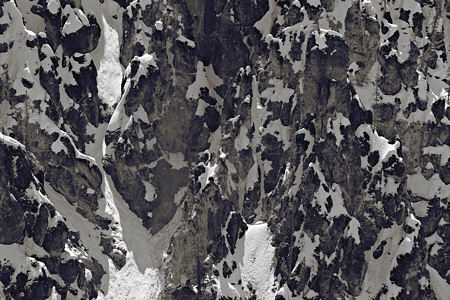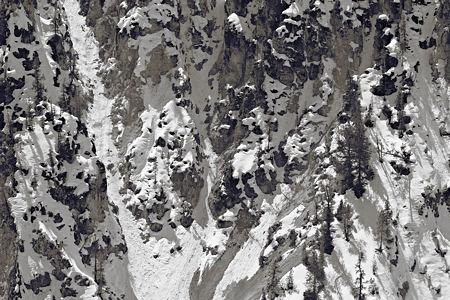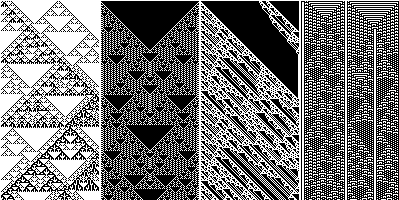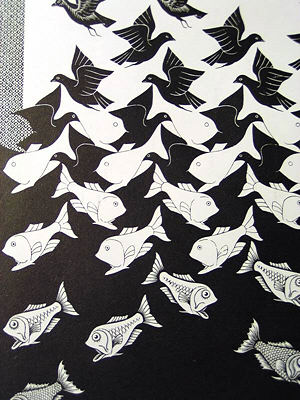Continuing my recent Yellowstone visit after leaving the geyser basin, I headed for for the Canyon area. In the past I’ve tended to focus on the magnificent falls there. This year, extra deep snow made access to the best locations difficult (not to mention forbidden, though that’s of lesser concern). I spent my time instead looking at the steeply sloping walls of the V-shaped canyon carved by the river.
 1
1
The image above gives an idea of the view across from my lookout. But the scene really came alive for me after I narrowed the field of view to just a patch of the wall. As I mentioned in an earlier comment, I slipped into a mode where I was fascinated by the scene that could be viewed as both an allover abstract texture and a wealth of realistic detail of rocks, trees, avalanche tracks, etc.
 2
2
 3
3
 4
4
 5
5
That may be too many examples, but they have variety in the proportions of different tones. The general composition of the scene, with its line of trees at the rim, reminded me of a Larry Poons drip painting entitled Old Dominion:

However, I find the drip texture in the lower half of the painting rather predictable and boring, whereas the canyonside pattern never loses its interesting mix of structure and randomness. The texture of Poons’ recent work (e.g. the 2007 painting Duetto shown below) makes a better match.

But just now, as I write, what I am really reminded of are the patterns generated by cellular automata, mathematical algorithms that can create both repetitive and unpredictable patterns, depending on the rules chosen to govern them.

These patterns evolve according to their rules in a downwards direction. No doubt analogies could be found to the evolution of the canyon wall, driven by the algorithms of erosion. To do so might, for some, detract from the natural beauty of the place. To me, it can only add to its mysteriously compelling power. It illuminates, in yet another way, how past time is present in what we see today.

Steve:
Images one and four, but I might choose differently later.
Bought a doorstop by Stephen Wolfram out at Barnes and Noble for six bucks. I gave up trying to count the number of times that he referred to himself as author of a new kind of science. Makes me wonder how a given cellular automaton would behave if it were made to promulgate itself, not into a void, but under the influence of a historied and irregular surface.
Jay,
That was a bold purchase you made. It says a lot about your relentlessly inquiring mind–or else about the contrariness of your doors. Wolfram does have quite a high opinion of himself. Perhaps warranted, but still off-putting. I never tried to read his book, despite my interest in the topic.
That’s a very intriguing idea of yours to consider an automaton that responds not only to the previous generation of its social history (reflected in the row above), but also to the environment it traverses. It certainly comes closer to representing something about the real world. I think that many ecological and other simulations could probably be cast in that light.
Steve:
At six bucks it was a steal. I have it on one of those pedestal tables such are used for the Oxford Unabridged, and keep a candle lit in its presence.
Of course it casts its own glow.
Cellular automata give me the creeps, along with all those fractals that you see at Spanky.
Steve,
All downward — perhaps cut down by the river — but perhaps driven upward by the tectonic forces of earth plates (did you know there are 20 of those things pushing us about?)
I would have to say that of course past time is seen in all we see today, although sometimes it’s hard to name and therefore see it. Near Beatty Nevada is a formation called, I think, “chaos.” For the obvious reasons — it made no sense whatsoever to the geologists. (Can you tell I’ve just reread Basin and Range?)
But you say “downward” and I say “upward” — does that make a difference? Yi-Fu Tuan (“Space and Place: the Perspective of Experience”) reminds us that humans have up, down, front, back, left, right, and that in various cultures, each direction has certain, if subtle meaning. Front however almost always means future, whereas back means past.
I myself have thought the directions were seven: north, south, east, west, up, down, and here — the last being the most important. So the “downness” of your perspective indicates that you were taking the photo from across the way — partway “down” the face of the other side.That seems significant.
I’d ask about Wolfram, but am afraid I’d get an answer. I still have to deal with Birgit’s author.
And oh yes, as sheer visual delights go, I like the one with the diagonal — 4th from top — best. But it isn’t Poons. Or maybe “and” it isn’t Poons.
S
While finishing the very last of my coffee, I watched the settled-grounds at the bottom of my cup slide its way down almost to my lips. I appreciate your waver between the experience and the art. Or something like that.
June,
I like your enumeration of the seven directions very much. Using space as metaphor for time, it’s true that forward is future, behind or back is the past. But it’s more confused for movement in time, as when an appointment is changed. Is making an appointment further in the future moving it forward or moving it back? There’s a conflict between forward as towards the future and forward as towards us.
On down vs. up in the image: I had meant that the formation process was erosion with water and rock moving down. But visually, the upward arrow shapes (dark in #1) are equally prominent as the down arrows (light in #1). So it does become quite interesting, and subject to individual judgement, which direction of movement wins out. Or maybe it’s having both, with the tension between them, that matters most. Reminds me of Escher’s crossing migrations, especially this one:

I failed to number the images originally, but have done so now. Your #4 has a brighter diagonal, but the main diagonal of #3 is broader and seems stronger to me (not that that makes it better necessarily).
As for Wolfram, his Wikipedia page is probably as good a place as any to start.
D,
I appreciate your observation. As it happens, I’ve had a plan for the last two years to do a photographic study of almost exactly the phenomenon you observed, except with tea rather than coffee. Partly for the variety of teas available, partly for the metaphorical overlay. But mostly for the sheer fascination of the patterns created.
Steve:
To get back to something. I suppose the automaton could progress across its customary cellular grid but with a separate value or rule defining each cell. I would imagine that a pixelation of one of your images, with each pixel assigned a number based upon a local pictorial characteristic, could serve as a usable matrix. S.W. may have anticipated this rather obvious strategy, but I like the book right where it is. I have it holding a door open, not closed – if you get my drift.
My impulse as a viewer might be to regard the product of these operations as a form of abstraction. But then, maybe not.
Serendipity/Sycnchronicity….(sp?)…
I looked up Steve Wolfram, and then mentioned him to my son, He replied that Wolfram was on NPR Science program today and that there is a web release/demo about Wolfram’s computational information system… http://www.wolframalpha.com/screencast/introducingwolframalpha.html
Interesting guy, apparent genius or idiot savant…which of his books are you referring to, Steve?
I’m afraid this blog will eat my life…
Jay,
The product of such play could potentially be a form of aleatoric art, the art residing in the choice of rules and initial conditions, and the later selection among the results produced deterministically from those first choices. It might be amusing, but doesn’t feel worth the effort.
Bruce,
The book that serves as Jay’s doorstop is A New Kind of Science. That, I predict, will eat your life if you get into it. There’s a YouTube video on John Conway’s game of Life, a 2-D grid of cellular automata of the sort that Jay and I are thinking of.
I hadn’t heard the term, aleatoric art…but some interesting examples of color images generated by algorithms for mutation over thousands of generations are at http://icewater.cms.udel.edu/babel/ These are small images, made to be viewed on small screens. The site also has Qtime movies of the evolution of the patterns.
These are a project of my son, Adam Marsh, a Marine Biologist doing work in genetics. He was running a similar project for strings of nucleotides, and realized he could easily write the code (in Python) to generate mutations of color. He begins with a random pattern of tiles, and then allows the RGB values to mutate, with the code biased toward increasing uniformity of color. He has run some through more than a million generations.
I have run a number of trials on my Mac…I don’t write code but he has set it up so that a varieety of parameters are easy to tweak. Interesting to watch them evolve. We are discussing ways to write the code to encourage development of shapes, and lines of specific directions.
The idea is related to Borges “Library of Babel”…an finite library of all possible books which could be written with the 26 charadters of the alphabet and spaces and periods. That library would be bigger than the universe…but complete. This project could generate all possible pictures….given a few billion years and some massive machines.
Maybe more interesting than cellular automata….
Steve:
You know, it does sound potentially trivial as a form of permutations to nowhere. But Wolfram cites examples of progressions of sameness that go on seemingly forever, only to produce a change. Granted the change itself can be as trivial as it is surprising. But inferred is the chance that the change may be significant to somebody. The art in it would be meditative as a screen in a quiet setting, and in company with individuals assuming a sort of anticipatory monkhood, would present a cellular automation as it progresses An alteration in the routine would be non-trivial for its very happening.
A New Kind Of Science it is, and we know so at Wolfram’s tediously repeated insistence. Doorstop that it is, it could make a very small but comfortable sofa for all of its padding. Kidding aside, a Wolfram for Dummies would do me a lot of good.
Bruce:
As you are finding out, there are a number of compulsions on display here. So here’s one: would Babel’s library be so large as a collection of bound volumes, or as information stored, say, on microchips?
The idea of a piece with long, slow progressions, and small maybe trivial changes, reminds me of a Warhol movie… “Sleep”….6 hours of someone sleeping with no apparent edits or camera moves. The slightest change or movement becomes a dramatic event. There was also a film….”WaveLength”, by Michael Snow, 1967..which was a 45 min zoom…from a full view of a room to a full frame shot of a photo of the sea taped to a wall. The time was occasionally interrupted by bits of sound…music, some vague dialogue, and a murder.
Borges wrote the short piece in 1940…so he was thinking of paper and ink. But in addition to size the problem of computation time, to generate the library, is also huge…every possible book would include Moby Dick, and Moby Dick with one letter in the wrong place…ad infinitum. Likewise a ‘Gallery’ of Babel, with all possible pictures, would have “Guernica” in a cormplete version, and a version with one pixel misplaced, and a version interrupted with 1/2 of Velazquez’ “Las Meninas”, etc……
I found an amusing review of Wolfram’s book;
A Rare Blend of Monster Raving Egomania and Utter Batshit Insanity
see: http://www.cscs.umich.edu/~crshalizi/reviews/wolfram/
I’m very happy with seeing such a number of compulsions here; I’m sure I have a rare and accelerated case of AADDD.
Jay,
Nice move, if I understand correctly: the meditative happening becomes the art. You should be a basketball player or a politician. Naturally, I don’t denigrate the art in creating an interesting simulation, nor of course the science. It’s just not what I want to do at the moment.
Bruce,
For the most part, the devil is in the details of your (or Adam’s) “aesthetic” function. To get shapes (implying edges), you may need edge-related criteria, such as that smooth edges are good–a sort of surface tension. The competition between edge and area contributions to overall goodness can play out in very intriguing ways. You could also make the 2-D space anisotropic: up-down interactions are different from sideways ones. Endless possibilities…
The book review you cited was great. Rather technical, but very plausible and well-argued.
Steve;
As it is currently set up each pixel, or tile, looks at all it’s immediate neighbors, and mutates toward uniformity…being numerically more similar in it’s RGB values to it’s neighbors.
Adam and I have discussed ways of encouraging development of shapes…having the pixels respond and mutate toward their neighbors in specific directions…toward the north neighbor, or the southeast…and have randomly selected areas with different direction biases. If it happens I’ll let you know. My grasp of the mechanics is a bit vague!
The “aesthetic” or “organizing” function is very simple so far…simply rewarding greater color uniformity. Differences are made by slight adjustments of the rates of mutation allowed for R or G or B. The program is also written so that when a ‘plateau’ is reached….several generations run with no improvement, the program backs off to an earlier state and restarts there, seeking a more ‘fertile’ path.
I think they are interesting ways to think about evolving structures,and may be able to answer some empirical questions…but their relation to my sense of the nature of art is very tenous.
Bruce:
For whatever it’s worth, I Googled “Utter Batshit Insanity” to find that the appellation tends to dwell almost exclusively on Wolfram. Would that we all enjoyed such attention.
Your mutating examples are colorful and not at all what I would imagine a uniformity tropism to produce. In fact, it would seem that things should go all RGB gray – even with the resetting mechanism.
Steve:
There could be a payoff: a recognizable change could trigger a chalupa giveaway at Taco Bell, or absolution for sins of omission committed during times of programmatic uniformity. Things wouldn’t have to be all that monkish as the curious might drop by. But credibility in the eyes of one’s fellows would depend upon resolute adherence to the screen.
A hoop and a holler perhaps?
Jay;
The program allows you to set a maximum rate of mutation for each generation, and then to allow the R and G and B values, of each pixel, to randomly vary by a percentage of that rate. Each of the component colors is given a slightly different limit, so a uniform gray field never occurs.
Like…Max. Mutation rate for each generation = .05
Max Mutation rate for R = .50 of .05
Max Mutation rate for G = .48 of .05
Max Mutation rate for B = .52 of .05
The resulting image will be biased toward Blue Violet. The mutations are random, within these limits. I don’t know why Adam chose these particular rates.
A fragment of the Mona Lisa, or Dogs Playing Poker, has not yet appeared.
I enjoyed running small quick tests…20 X 30 tiles to get quick results. I’d wanted to run some big ones over weeks…like 240X320, which could be displayed on small screens with every tile a pixel…for extremely smooth transitions. But for some reason my MacPro would randomly crash within a few hundred generations, and we didn’t have the time or inclination to track down the problem. Adam runs them with no problem on both his mac and on Unix servers.
I have an inkling that they may have some relevance beyond being pretty patterns.
I’ve fooled a bit with programming an Arduino board to control a RGB led, and it can run the led thru the whole palette of RGB values.A crazy idea from this would be to hand build an array of RGB leds, essentially a small monitor, and connect them to a grid of sensors on the film plane of an old view camera….it could be medieval, perhaps gothic, video. Focus the camera on odd subjects on sunny days….
This idea…which I totally lack the time or inclination to pursue, is related to work Jim Campbell does with lo res hand built monitors of monochrome leds.
http://www.jimcampbell.tv/
Bruce:
Very interesting. Puts me in mind of an old technology that seems to have fallen out of favor. I’m referring to fiber optics: a kind of pixel-by-proxy scheme where light is piped along separate strands of transparent material. The resolution of a resulting image is limited by the number of strands. Succumbed to the mini-cam.
Seek an attitude of monkish anticipation, and some monkish libation and you may be visited by a fragment of the pink elephant – preferably Seussical.